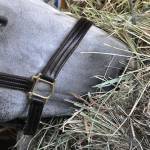Fibre: The Basis of Feeding Horses

The horse evolved to eat one type of food: grass. Good-quality pasture or roughage should be the prime ingredient in the diet. Roughage contains fibre, which aids digestion, satisfies hunger, and meets basic energy requirements. Access to an adequate supply of fibre decreases the incidence of wood chewing.
Fibre is an energy source that is often overlooked in horse nutrition. The fibre portion of the plant is made up primarily of cellulose, hemicellulose (digestible fibre), and lignin (indigestible fibre). Cellulose and hemicellulose are broken down by the microbial population in the horse’s hindgut to volatile fatty acids (VFAs) that are used by the horse as a form of energy. The VFAs are readily absorbed into the bloodstream, where they are either transported to sites that need energy or stored in the form of fat or glycogen.
Lignin comprises the structural support of the plant and is not digestible by the microbial flora. As a plant matures, the proportion of lignin increases and consequently the digestibility of the forage decreases. Therefore, the longer and more mature the grass, the less digestible it is. As a rule, if there is more leaf than stem in a forage source and if the stems are not stiff and inflexible, the digestibility will be higher. Fresh green spring grass will have more digestible fibre per kilogram than dry summer grass, and hay or chaff cut prior to maturity will have more nutritional benefit than hay or chaff that is allowed to mature before cutting. Pasture is also more digestible than hay or chaff because the drying process results in a loss of digestible fibre.
Feed requirements are calculated on a dry-matter basis, which means after any water has been evaporated from the feed. While pasture forage varies from 30% to 60% dry matter, most supplementary feeds are about 90% dry matter. To calculate the dry-matter weight, multiply the raw weight of the feed by 0.9, except in the case of pasture.
Horses require a minimum of 1% body weight in forage every day to maintain correct digestive function, and the rest of the diet should be designed around that minimal forage requirement. Mature horses will generally eat 1.5–3% of their body weight per day in dry matter, depending on the type of feed and individual variation. Growing foals may eat up to 3% of their body weight in a day.
The horse’s energy requirements determine the amount and type of feed. Horses at rest or only lightly exercised can meet their energy requirement from pasture alone, but young growing horses, pregnant or lactating mares, and performance horses usually need more energy than can be supplied by roughage alone. Supplementary feeds may be either concentrates or roughages. Concentrates are grains and meals, which contain a lot of energy, and roughages are hay and chaff, which are low in energy but high in fibre.
In order to make informed decisions about the use of supplementary feeds, you must evaluate the current nutritive value of the ration and whether it meets the requirements of your horse. If supplementary feeding is necessary, use a minimum number of good-quality feeds (this will also help reduce feeding errors if other people have to do the feeding for you at any time). Do not introduce too much variety to the diet unless it is essential for balancing the ration.








